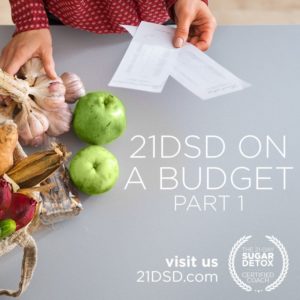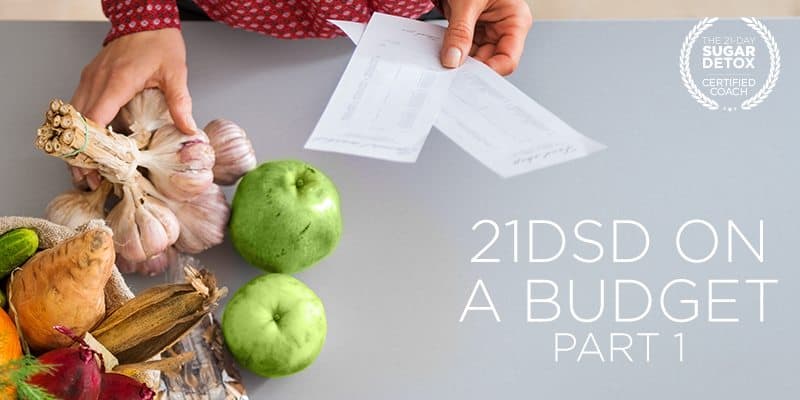Hey Folks! We're excited to welcome back Certified 21DSD Coach Beth Romanski. Beth's article is part of a series contributed by our Certified 21DSD Coaches. Enjoy! – Diane and Team
You’re ready to start your 21DSD on the right foot and you’re following the Pre-Detox Checklists to the letter: cleaning out your pantry and getting ready to stock it with all new 21DSD-approved foods. Then you find yourself at the grocery store faced with a bill at the checkout counter and you’re a shocked (and a little panicked) by the total. You know this is an important investment in your health, but it still might be enough to put a doubt in your head about adopting this new healthy lifestyle.
You know deep down this is the best thing for you to do for many reasons (improved self-esteem and moods, to stop feeling out of control around sugar or processed carbs, better sleep, or to prevent more serious long-term health issues like Type 2 Diabetes), but it is so expensive!
Maybe your partner won’t be as supportive if he/she sees the grocery bill creep up. While it’s true that some of my clients who take prescription medication are able to go off it after shifting their diet and completing a 21DSD, which can be much bigger savings long-term, right now this may not be what you’re thinking.
As a Health Coach, you may assume that I’m here to say “suck it up” and do what you need to do, no matter what it takes–no excuses. But as an average person with a budget myself, I can relate to how you feel. Why does healthy food have to cost more? While the answer to that question is a separate blog post altogether (and a rant about the downfalls of the U.S. food system), what is most important to you is finding ways to make healthy eating affordable and accessible long-term so that your 21DSD is a jumping off point for a lifestyle change.
 I’m not going to lie, if you’re just starting out on the 21DSD from a SAD (standard American diet), it may be a greater initial investment up front, but I assure you it’s TOTALLY worth it to have all the healthy items you need on hand to make good choices and tasty meals.
I’m not going to lie, if you’re just starting out on the 21DSD from a SAD (standard American diet), it may be a greater initial investment up front, but I assure you it’s TOTALLY worth it to have all the healthy items you need on hand to make good choices and tasty meals.
21DSD-friendly foods aren't just for convenience so you don’t resort to unhealthy choices and cravings; you need to have them available because you’ll want to continue your newly learned healthy habits. You will need these foods for more than 21 days.
So now the question is…what to buy? Most of the guess-work has been taken out of it for you if you simply follow the must-haves on 21DSD Stocking the Pantry and Shopping List Guides which you can download here!
Of course there are great Recommended Products lists on page 224-225 of the 21DSD Guidebook. You don’t have to buy the “fancy” specialty foods to be successful on the 21DSD program. I promise! Even if you just stick with the basics that you may not already have in your pantry (like canned coconut milk, coconut flour, coconut aminos and hot teas), you can do well on the 21DSD.
Here are a few of my best tips to keep in mind to make you relax about your investments and impact on your wallet (and waistline):
- Buy in bulk at discount stores. We all love Whole Foods, but believe it or not, large discount membership stores are actually ahead of the curve when it comes to stocking some healthier options, thanks to changing consumer demands nationwide. So you don’t feel lost when you go, Diane has already put together an amazing list of resources for you to take with you to the store! If you don’t have those Healthy Shopping Lists, download the PDFs here. Trader Joe's is another great option if you are lucky enough to have one near you, or you can take a healthy road trip with friends to stock up on some pretty amazing food at affordable prices!
- Order online. Amazon or Thrive Market are great options where you can find some 21DSD staples at a better price due to their ability to source vendors. I don’t know about you, but I like when food is delivered to my door without me having to waste time or energy shopping for it! J
- Eat in season. You may not be able to grow all your own produce (though I highly recommend doing this if you can…even if it’s just herbs), but shopping at local markets (or even in the grocery store) based around seasonal availability can really make a difference on your budget. Fall root vegetables and green apples are still around at your local market in the fall. You may have heard about a CSA (community supported agriculture) program, so you can find one in your area and share the costs with a friend if needed. If you are someone who cans or freezes, use the seasons to store fruits or other seasonal produce for winter when they are harder to find at a reasonable price.
- Frozen is a “yes.” We’re told to shop the perimeter of the grocery store to avoid packaged foods, which is still a good idea, but one inside aisle I frequent for vegetables is the frozen section. Believe it or not, frozen veggies still contain all the nutrients as fresh and they are usually a fraction of the price, especially if you’re buying at the grocery store and not a farmers market or in the off-season.
See some ideas you want to try? I’ll have even more tips coming up in Part 2 of the 21DSD on a Budget series, so stay tuned!
If you like what you’ve read, join me and my fellow 21DSD Certified Coaches for a very special free online summit April 24-28, 2017 – HEALTH COACH SECRETS! Register here!
 Beth Romanski is a Certified Health Coach and graduate of the Institute for Integrative Nutrition. Beth takes a personalized approach to health coaching, working with clients to create custom nutrition blueprints and individualized coaching programs to meet their needs. Beth is passionate about spreading the message of health and happiness through education, with a supportive and empowering style.
Beth Romanski is a Certified Health Coach and graduate of the Institute for Integrative Nutrition. Beth takes a personalized approach to health coaching, working with clients to create custom nutrition blueprints and individualized coaching programs to meet their needs. Beth is passionate about spreading the message of health and happiness through education, with a supportive and empowering style.
Visit Beth’s website at www.myhealthytransitions.com to learn more about her one-on-one coaching programs, to sign up for the MyHealthyTransitions email newsletter, or to request a complimentary health coach phone consultation as a special offer for 21DSD Blog readers.


Comments 3
Pingback: 21DSD on a Budget – Part 2 - The 21-Day Sugar Detox by Diane SanfilippoThe 21-Day Sugar Detox by Diane Sanfilippo
I may be already signed in some way but I will need help with the budget part. I am an overweight, cardiac, 80 year old woman. I live in a ‘busy’ 4-generation household. Your help will is appreciated. Thank you and God bless you. Sheila (aka. Nannie Mae} Will try 🙂 to do some downloads in the AM
Hi Sheila!
A coach sounds perfect for you! We have a great network of coaches, you can find one to connect with here: http://21dsd.com/coaches. -Moriah, Team 21DSD